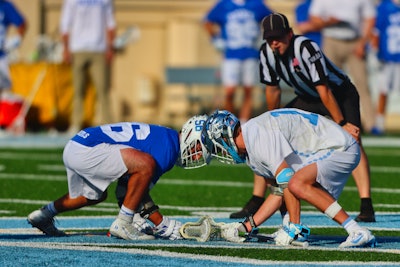
The United States Military is actively discussing an initiative, proposed by a defense contractor, to fund athletic scholarships for tens of thousands of college athletes each year in exchange for their mandatory service.
The proposal, which would not include football and basketball players, has reached military and civilian leaders throughout the Department of Defense and key members of Congress over the past seven months, according to a Sportico report. It has been pitched as a solution to inefficient recruiting within the armed forces — which spend billions on recruits who fail basic training — and financial unease in college athletics, where athletic departments face increasing cuts to non-revenue teams such as tennis and wrestling.
According to Sportico, the proposal is very likely to draw pushback from some key stakeholders, including the NCAA and its member institutions. "That’s before the task of convincing high school athletes, an attractive demographic to military recruiters, that a college athletic scholarship is worth a commitment to years of military or alternative civilian service once they have completed their schooling," wrote Sportico's Eben Novy-Williams and Daniel Libit.
Dave Maloney, a former Auburn University track athlete and current CEO of Orchestra Macrosystems, a Houston-based software and analytics company that is an Air Force contractor, came up with the idea, Sportico Reported. In a September memo that has since circulated around the Pentagon and Capitol Hill, Maloney framed his plan as a “21st century pathway to service.”
The Scholar-Athlete Intelligence and Leadership Program (SAIL-P), as it is christened in Orchestra’s brief, suggests that DoD offer to replace school-funded athletic scholarships for every sport other than football and basketball at the collegiate level.. Those athletes would have no obligations while in school, but would be committed to a yet-to-be-determined amount of service after they’re done. Orchestra’s role would be to provide the market intelligence and data analysis to help power the program.
Maloney said his plan would not only relieve the multimillion-dollar financial burden of athletic scholarships, but it could allow schools to offer more aid to more athletes. According to Sportico, the average D-I men’s lacrosse team fields 49 athletes, but the NCAA only allows schools to offer 12.6 scholarships for the sport. Most men’s lacrosse players are on fractions of a full grant-in-aid, if they are receiving anything at all. Should the government adopt this plan widely, across multiple departments, branches and intelligence communities, Maloney said its scope could eventually cover hundreds of thousands of college athletes each year.
It would also reduce the military's substantial recruitment outlay.
Last month the Pentagon requested a record $773 billion budget for 2023, including about $1.32 billion in “recruiting and advertising” costs across the four major military branches, and billions more for the basic training of those recruits. By comparison, the 100-plus public FBS schools reported spending $653 million in scholarship costs outside of football and basketball in 2020-21, according to Sportico’s college financial database.
“The Department of Defense just went to Congress with its initial budget for next year," Maloney said in an interview. "It’s the largest budget ever, and yet we’re seeing a decrease in our technological capabilities, and we’re seeing a decrease in any interest in service, What does that tell you? Talented people don’t want to work at decaying institutions. You’ve got to gut-punch it.”
Maloney said he and his paid advisors have formally discussed the proposal with a number of high-ranking officials in the military, U.S. Intelligence Community and Department of Transportation. Meanwhile, an NCAA spokeswoman said the governing body was unaware of the proposed initiative before being contacted for this story, declining to comment further.
According to Sportico, NCAA bylaws likely wouldn’t restrict the federal government from funding athletic scholarships in exchange for mandatory service. The military academies already offer scholarships to athletes who have made these commitments, typically eight years total with at least five on active duty.
University of Notre Dame athletic director Jack Swarbrick was initially “shocked” when a reporter described the proposal, but suggested he would be open-minded if it gained steam. “We happen to have one of the more vibrant ROTC programs in the country, so we’re already involved in the military,” Swarbrick said. “I have about 101 questions, but would I listen? Sure.”





































